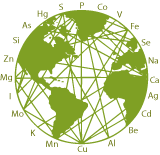Facts
Zinc is an essential nutrient for humans and animals. It is necessary for the function of a large number of metalloenzymes, including alcohol dehydrogenase, alkaline phosphatase, carbonic anhydrase, leucine aminopeptidase, and superoxide dismutase.
Zinc deficiency has been associated with dermatitis, anorexia, growth retardation, poor wound healing, hypogonadism with impaired reproductive capacity, impaired immune function, and depressed mental function; an increased incidence of congenital malformations in infants has also been associated with zinc deficiency in the mothers. The recommended dietary allowance (RDA) for zinc is 11 mg/day in men and 8 mg/day in women; these correspond to approximately 0.16 mg/kg/day for men and 0.13 mg/kg/day for women. Higher RDAs are recommended for women during pregnancy and lactation (12 mg/day).
Toxicity is rare. Overexposures has been associated with toxic effects.The recommended upper limit in adults for zinc intake is 40 mg/day; the upper limit is lower for infants and children.
Ingesting doses of elemental zinc ranging from 100 to 150 mg/day for prolonged periods interferes with the copper metabolism; higher doses of zinc should be given only for short periods of time and under medical supervision.
Ingesting larger amounts (200 to 800 mg/day), usually by consuming acidic food or drinking from a galvanized (zinc-coated) container, can cause anorexia, vomiting, and diarrhea. Chronic toxicity may result in copper deficiency and may cause nerve damage. Inhalation of Zinc fumes can cause symptoms of zinc toxicity and usually occur 4 to 12 hours after exposure. Symptoms usually resolve after 12 to 24 hours in a zinc-free environment.
Zinc | Toxicological Profile | ATSDR
Zinc Toxicity - Nutritional Disorders - Merck Manual Professional Edition
